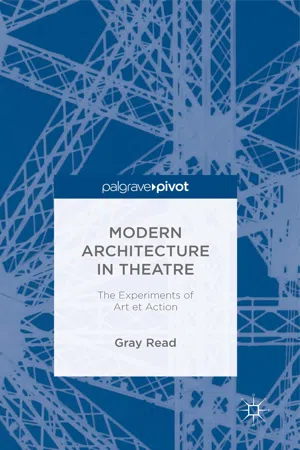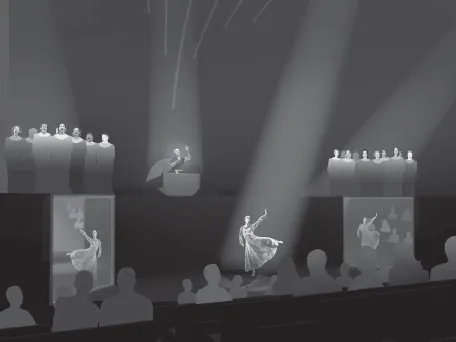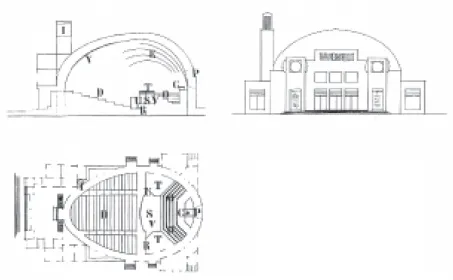
This is a test
- English
- ePUB (mobile friendly)
- Available on iOS & Android
eBook - ePub
Book details
Book preview
Table of contents
Citations
About This Book
If the city is the theatre of urban life, how does architecture act in its many performances? This book reconstructs the spatial experiments of Art et Action, a theatre troupe active in 1920s Paris, and how their designs for theater buildings show how the performance spaces interacted with actors and spectators according to their type.
Frequently asked questions
At the moment all of our mobile-responsive ePub books are available to download via the app. Most of our PDFs are also available to download and we're working on making the final remaining ones downloadable now. Learn more here.
Both plans give you full access to the library and all of Perlego’s features. The only differences are the price and subscription period: With the annual plan you’ll save around 30% compared to 12 months on the monthly plan.
We are an online textbook subscription service, where you can get access to an entire online library for less than the price of a single book per month. With over 1 million books across 1000+ topics, we’ve got you covered! Learn more here.
Look out for the read-aloud symbol on your next book to see if you can listen to it. The read-aloud tool reads text aloud for you, highlighting the text as it is being read. You can pause it, speed it up and slow it down. Learn more here.
Yes, you can access Modern Architecture in Theatre by A. Read in PDF and/or ePUB format, as well as other popular books in Media & Performing Arts & Theatre. We have over one million books available in our catalogue for you to explore.
Information
Subtopic
Theatre1
Hearing the Voices of the Universe: Choral Theatre
Abstract: Choral theatre performances of simultaneous poetry surrounded audiences with atmospheric music, voice, light, and dance to create a modern spiritual experience that reinvented the ancient Greek chorus, using Futurist ideas of polyvocal simultaneity and synaesthesia or cross-sensory perception. Autant proposed an acoustic shell structure to reflect orchestral music into full resonance, while multiple choruses sang poetic verses as vocal figures suspended in the sound-laden air. Auguste Perret’s 1928 concert hall, the Salle Cortot, similarly transforms the music “like a violin.” Two of Perret’s churches include hollow towers that resonate music in a deep hum, as if from the earth itself. In the artistic circle of Autant and Perret, this shared immersion in sound was considered a secular form of spiritual communion.
Read, Gray. Modern Architecture in Theatre: The Experiments of Art et Action. New York: Palgrave Macmillan, 2014. DOI: 10.1057/9781137368683
In 1917 Art et liberté presented a choral poem “Le Sacre du printemps” (Rite of Spring) by Sébastien Voirol, which reinterpreted the iconic music of Igor Stravinsky written for a famous performance by the Russian Ballet four years earlier.1 Art et liberté’s performance included two choirs and several soloists, each chanting distinct parts that merged with and separated from one another in a complex pattern. A choir of men sang simultaneously with a choir of adolescents yet were spatially separated from them. A “300-year-old man” chanted parallel to a chorus of “elders who knew the rituals of the night,” and a “pale young man sang with a young woman whose eyes were cast down.”2 An orchestra accompanied the singers and rendered some of the poetic themes musically, adding another layer to the composition. In addition, Louise Lara danced a ritual of struggle and release. The performance demonstrated the principles of artistic simultaneity by presenting multiple independent parts that intersected each other.3 Between the sounds of spoken or chanted words, the instrumental music, and the dancer’s gestures, spectators might perceive in their own minds sparks of poetic correspondence. At least, that was the artistic intention. Listeners of the actual performance, however, may have had a hard time distinguishing the words, because the simultaneous choral parts of the poem were performed on a single, central stage, so they were not separated spatially. The words probably muddled together, disrupting any sense. Newspaper reviews of similar choral pieces by Art et action readily denounced them as unintelligible cacophony.4
Yet Autant and Lara persisted. Autant wrote that composing words and music for three-dimensional space transformed poetry into a bodily experience of sound and sense that possessed the immediacy of real life.5 In subsequent works, such as their 1929 presentation of Arthur Rimbaud’s “Une Saison en l’enfer” (A Season in Hell) Autant and Lara conceived the performance architecturally. They placed the multiple performers around the audience, giving the voices specific locations.
Studies of auditory perception show that if listeners can locate a sound spatially, then they can focus attention on it and screen out other noises—a skill honed in cocktail party conversation. Spatially separating the voices makes it possible for listeners to focus attention on one voice among many or to shift attention from one voice to another at will. In Art et action’s performances with spatially separated voices, listeners could cast attention from voice to voice and construct multiple meanings out of the simultaneous verses.

FIGURE 1.1 Interior view of Choral Theatre (Théâtre Choreique) based on sketches by Edouard Autant (Damir Sinovcic and author)
This spatial innovation in performance, Choral Theatre, was the first of Autant and Lara’s five conceptions of dramatic structure and established the poetic core of their quintology of theatric form. In 1933 Autant sketched a building for Choral Theatre with an egg-shaped dome enclosing audience, choral singers, and orchestra in a single, resonant space (Figure 1.1). Although the theatre was never built, its unusual design suggests acoustic qualities that would give sonic depth to performances of simultaneous poetry, as composed by their artistic collaborators.
The acoustic design Autant sketched for the choral theatre building relates to that of a concert hall and two churches by Auguste Perret, which still stand. The interior volumes of these buildings reflect sound to create dense sonic atmospheres that surround listeners on all sides, as if they are suspended in music; each new phrase of the melody arriving as a crisp figure written in the air. Architecture and sound are integrated so fully that Perret’s design makes sense only in performance and the music for which the spaces are designed seems to come to life only there. This unity of building and sound recalls the stone vaults of medieval chapels, which measured to the resonant dimensions of monastic chant, building the voices spatially into bone-vibrating prayer.6
Autant explained the spiritual role of choral theatre: “What would be the human voice without the purpose of expressing the harmonious life of worlds at every height and at all sequences and extended in all directions, ideal waves of thought that join the waves of the universes; the horizon and the undulation of the sea and the wind, the pulsation of the ephemera of our blood and spirit?”7 In this light, the spatial sound of Choral Theatre constructed by both Autant and Perret can be read as a proposal for a modern spiritual ritual in the city that celebrates a link between community and cosmos.
Art et action’s description of Choral Theatre performances alluded to the ancient Greek chorus in both form and vocal quality. Autant and Lara had adopted Edward Gordon Craig’s quest to reinterpret the Greek chorus for modern theatre, as a unifying voice in between audience and actors. Craig considered the chorus to be the primal element of ancient theatre, which created a spiritual space, or “choros,” within the real space of the city to reflect the encompassing cosmos in song.8 The collective voice and swaying movement of the chorus were human and present, opening a space of vision or theatron in the city. Craig likened the chorus to a natural phenomenon, like a flock of birds wheeling above Trafalgar square, “in their own god-like way.” He continued, “It was the movement of the chorus that moved the onlookers . . . time seemed actually to be in motion. The movement was felt, but felt through seeing.”9 Craig described the chorus as a human architecture that seemed to embody the city itself, singing the collective truths of the populace.
The poets in Art et liberté who continued to work with Art et action, invented modern simultaneous poetry as the complex voice of many individuals merged to sing a shared truth. The poet Fernand Divoire wrote, “Simultaneism is a way to sense the world in its unity of millions of voices—the ALL: voices, thoughts, noises, movements.”10 Poetry progressed from an individual voice to a collective song and then to a musical atmosphere, in order to construct a modern symbolic cosmology that unified the individual with the universe.

FIGURE 1.2 Choral Theatre sketches by Edouard Autant (Courtesy: Corti Press)
Note: Egg-shaped plan shows two raised platforms for choral singers (T), a central stage for dancers (S) with mirrors to reflect their movements (U), and an orchestra pit facing away from the audience, so the conductor faces toward the audience. Section shows the levels of performers and audience as well as heaters and chillers in domed ceiling. Key: Exhaust chimney for air movement (I); Platform for Orchestra Conductor (C); Tiered Orchestra Pit with moveable screen (O); Illuminated Stage (S); Choir (T); Soloist (V); Mirrors (U); Audience (D); Heating Units (E); Refrigeration Zone (Y); Exhaust Vents (R); Air Intake (P).
The Choral Theatre building in Performances of simultaneous poetry
Autant’s sketches for a Choral Theatre building describe an architectural form that would have the acoustical effect of giving specific locations to voices and music, so that an audience would hear them arrayed spatially. Instrumental music would surround listeners as if coming from all directions at once, while each choral group would hold a specific position, allowing listeners to locate each and attend to each independently. The musical rhythms would become visible in the movement of dancers on a central stage.
Autant drew the form of the Choral Theatre as two intersecting parabolas in plan, describing walls that curve up into an egg-shaped dome. Performers fill the wide end while the audience sits in the narrow end. The curving double shell, presumably built of concrete outside and plaster within, offers an acoustically reflective surface, which would gather and project the music of the orchestra toward the audience. The orchestra faces away from the audience and plays toward the curved wall of the shell, while the conductor stands on a high platform on the central, longitudinal axis, facing both the musicians and the audience (Figure 1.2, “O” and “C”). From this position, he sets the rhythm of the performance both visually and sonically with his baton. Flanking the orchestra, two platforms elevate choral singers almost to the level of the conductor (Figure 1.2 “T”). Singers face the audience so their words are heard directly, as opposed to indirectly, as is the case with the music. The multiple, simultaneous choral voices interweave with one another, yet each has a specific position in the hall. In the center of the space at a level lower than the conductor’s platform, a stage presents dancers in front of a blank wall onto which their shadows are projected, emphasizing their silhouettes (Figure 1.2 “S”). Two mirrors flanking the stage...
Table of contents
- Cover
- Title
- Introduction: Architecture as a Performing Art
- 1 Hearing the Voices of the Universe: Choral Theater
- 2 The Festival of Seeing Others and Being Seen: Theater of Space
- 3 Artistic Display and Commentary: Theater of the Book
- 4 The Spectator and Mass Media: Chamber Theater
- 5 Civic Debate: University Theater
- Conclusion: The Performance of a Town
- Bibliography
- Index